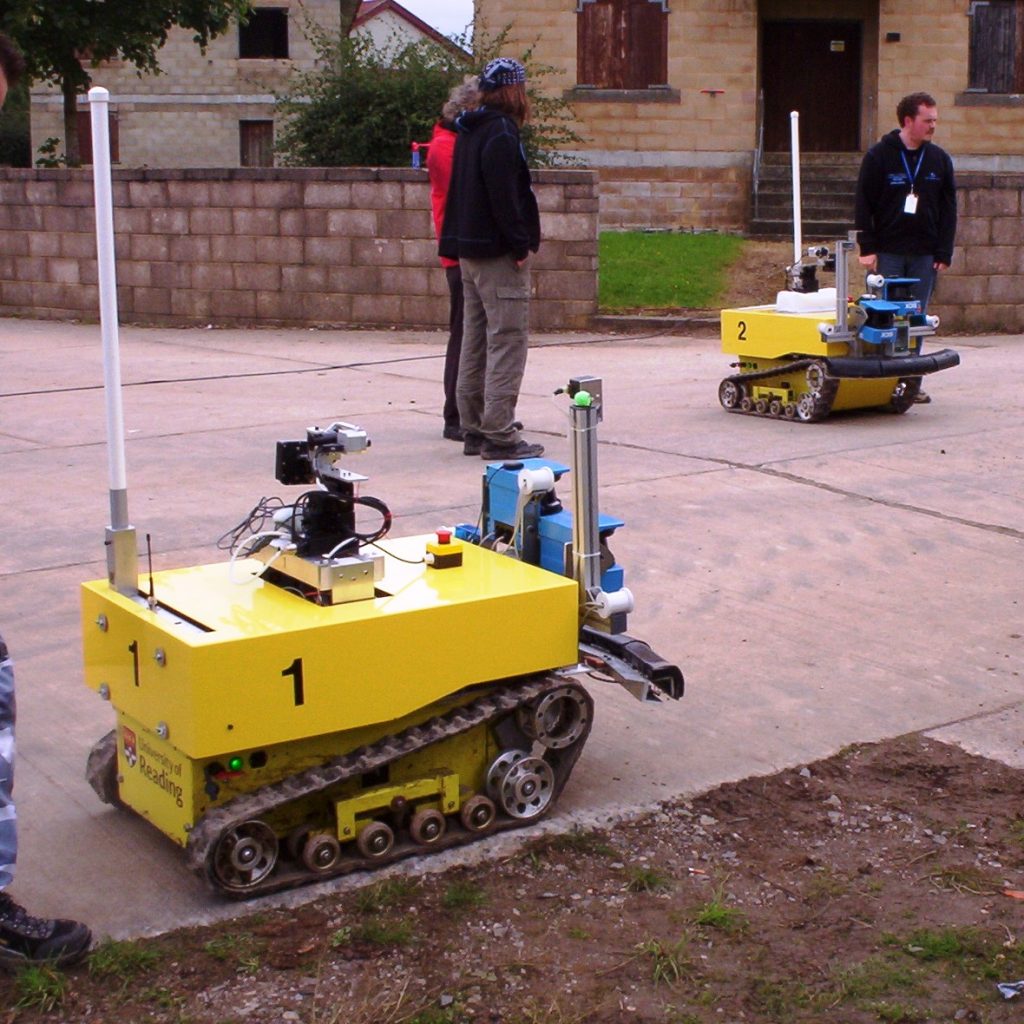Securotrack Robot Platform
Looking for a robotic platform that’s tougher than the standard four-wheels-on-a-box design? The Securotrack was originally developed for the Thales team in the MOD Grand Challenge (2008) and is a proven choice for harsher, outdoor environments.
We’re now seeking collaboration partners to develop new Securotrack-based applications, including Covid-19 response solutions.
The Securotrack™ is an electrically powered, high-speed tracked propulsion unit designed for remotely operated vehicles and robots. Easy to integrate with autonomous robotic software, it combines durability, versatility, and performance in one compact platform.
Key Features
- Flexible control inputs: Motor controllers accept quadrature and similar displacement pulses (acting like stepper motors) or velocity signals for full proportional forward/reverse speed control.
- High mobility: Maximum speed of 10 km/h (6 mph) with a ramped front for stair climbing and descent.
- Endurance: High-capacity batteries provide over 2 hours of continuous run time, extended further with regenerative braking.
- Track stability: Fixed radius configuration prevents track slippage, while paired intermediate rollers spread load and optimise turning on all surfaces.
- Compact design: 685 mm wide (fits through standard doorways) and 990 mm long (performs zero-turn U-turns in 1,219 mm / 4 ft passageways).
- Material options: Available in T6 aluminium (lightweight), steel (strength and fire resistance), or fibreglass with steel frame.
- Water resistance: Sealed hull allows operation through shallow water. With a sealed top, the Securotrack™ can achieve IP66 — withstands pressure washing on a ship’s deck without electrical damage.
Suggested Applications
The Securotrack™ provides a flexible base for:
-
Autonomous disinfection platforms
- Security robotics
- Remote firefighting (see Firemote)
- Telepresence solutions
- EOD (bomb disposal) — slow, precise manoeuvring
- CBRN (Chemical, Biological, Radiological, Nuclear) monitoring and wash-down
- Defence perimeter patrol
- Tracked wheelchair applications (adventure mobility)
- Operation in extreme environments (Antarctic, Arctic, desert, volcanic, toxic gas)
- Disaster response and demolition sites
- Film industry (remote camera mounts, prop movement)
- Factory workpiece movement
- Agricultural robotics
- Emergency service support
Proven Performance
We supplied two Securotrack™ units to Thales for use in the MOD Grand Challenge (2008). Working with Reading University, they mounted a semi-autonomous system using wireless instructions, GPS, and LIDAR guidance to navigate Copehill Down Training Village. The vehicles carried thermal imaging cameras to identify threats, supported by overhead surveillance drones that relayed wireless links. The Thales team won the Best Use of Talent Award.
Covid-19 Disinfection Concept
We are now seeking collaboration partners to adapt Securotrack™ as an autonomous outdoor and indoor disinfection platform.
Proposed features include:
- Chemical disinfection: Onboard tank, pump, and sprayer with multi-axis arm to treat outdoor surfaces such as benches.
- UVC lamps: For close-range indoor disinfection.
- Autonomous navigation: GPS, LIDAR, and IP sensors for fully automated operation.

ORIGINAL APPLICATION
We supplied two Securotrack™’s to Thales for use in the MOD Grand Challenge (see right). Thales and Reading University built and mounted a semi-autonomous system that used a combination of instructions via a wireless network, GPS and LIDAR guidance to enable the vehicles to navigate Copehill Down Training Village looking for threats using thermal imaging cameras. Overhead surveillance was done with remotely operated helicopters that also provided the relay for the wireless links. The Thales team won the Best Use of Talent Award.
COVID-19 DISINFECTION ROBOT
APPLICATION SUGGESION
This would make the ideal platform for an outdoor autonomous robot for overnight disinfection of public spaces to help combat Covid-19 and other infectious diseases.
How it would work
An onboard tank, pump and sprayer on a multi-axis arm would provide the chemical disinfection for outdoors (park benches, etc)
UVC Lamps would provide the close-range and indoor disinfection
A combined GPS LIDAR and IP sensors via an autonomous system would control the machine.
